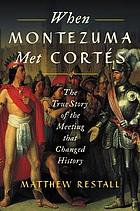
When Montezuma Met Cortés
The True Story of the Meeting that Changed History
- اطلاعات
- نقد و بررسی
- دیدگاه کاربران
نقد و بررسی

August 1, 2017
In his November 8, 1519, meeting with Aztec emperor Montezuma, Spanish conquistador Hernando Cortes is typically portrayed as a bold military genius triumphing over a temporizing enemy. But Restall, Edwin Erle Sparks Professor of Latin American History and director of Latin American Studies at Pennsylvania State University, offers a different picture.Chills from Mystery Writers of America Grandmaster Hart and Agatha and Macavity Award-winning MasseyPREPUB ALERT ONLINE: reviews.libraryjournal.com/category/prepub SIGN UP: ow.ly/60SSZ
Copyright 2017 Library Journal, LLC Used with permission.

October 15, 2017
A methodical deconstruction of the myths surrounding Hernando Cortes' "Mexican conquest" and the surrender of Montezuma. Restall's (Latin American History/Pennsylvania State Univ.; The Black Middle: Africans, Mayas, and Spaniards in Colonial Yucatan, 2013, etc.) main point is that the more you shift the point of view, the more is revealed. The traditional story fits the bill for all Western universal narratives in which civilizations are victorious over barbarism, thereby justifying invasion. The same goes for the usual claims that the natives were cannibals and sodomists, all used to make the victors look good. The story of Cortes landing in Mexico, being treated as a god, and accepting Montezuma's "surrender" to the great king of Spain is fiction. The author looks at the small force Cortes brought from Cuba to explore the coastline and sees an outnumbered group, fighting among themselves and overstepping their orders. He also reminds us of the "black legend" of the conquistadors as vicious, bloodthirsty murderers and slavers. The myth of Cortes is based almost entirely on his second letter (the first is lost) to the Spanish king in which his claims are nothing but fabrications. At the time of writing, he and his men were guests of Montezuma and nowhere near subduing this highly civilized people. It is the case of the victor writing the history, and Cortes' letter was the basis for it. Even more interesting is Restall's view of emperor Montezuma, whom history has called a coward. The author makes an excellent case for a strong leader of a civilization of tens of thousands in a city with gardens, palaces, and even a zoo at least a century before any European court. There was no need for him to fear the few hundred Spanish, and he was most likely toying with them, unaware of the cruel treachery that would result. Throughout, Restall's assertions are well-supported and difficult to refute, and the timeline that opens the book is particularly helpful. An engaging revisionist exploration of "one of human history's great lies."
COPYRIGHT(2017) Kirkus Reviews, ALL RIGHTS RESERVED.

Starred review from November 13, 2017
Restall (The Conquistadors), director of Latin-American studies at Penn State, makes an impressive and nuanced case for why radically reinterpreting the Nov. 8, 1519, encounter between Spanish conquistador Hernando Cortés and Aztec emperor Montezuma leads to a totally different view of the following four centuries. “The Meeting,” as Restall dubs it, is the founding myth of Latin-American history, an event that inhabits the liminal space between history and legend. What is known about the meeting has been gleaned almost entirely from one source: 16th-century foot-soldier Bernal Díaz’s True History of New Spain, which Restall argues is neither true nor strictly historical. Using his knowledge of the Nahuatl language to revisit forgotten texts and parse eyewitness accounts of the Aztecs’ “surrender,” Restall strips away layers of accumulated historical sediment to reveal a meeting that looks very different from the version found in history textbooks and memorialized in the U.S. Capitol rotunda. According to Restall, the meeting wasn’t a turning point but rather merely one moment in the Spanish-Aztec War, a brutal two-year struggle historically whitewashed in favor of an account that justifies and reinforces the European presence in the Americas and became the foundation for a false history of indigenous weakness and European superiority. Blending erudition with enthusiasm, Restall has achieved a rare kind of work—serious scholarship that is impossible to put down. Illus.

November 1, 2017
Restall (2012 and the End of the World, 2011), prolific author and director of Latin American studies at Pennsylvania State, takes on the enormous task of deconstructing the old mythistory of the Spanish Conquest, an event he renames the Spanish Aztec War. His painstaking analysis questions the essence of history itself as a discipline, an inquiry that is especially opportune in these times of truthiness and fake news. In this fascinating narrative, accessible to the general reader, Restall exposes the time-honored tropes that have well served colonial empires and manifest destiny. He reintroduces all the usual suspects, including Montezuma, Cortes, and Malinche, in a fresh, human context. It turns out that Montezuma was a kind of librarian, a collector and cataloger of flora and fauna, including the human variety. This kind of insight makes the book a clear-eyed, commonsense-based addition to the canon. A substantial resource, it also includes a time line, an incredible gallery of images, an appendix that includes a dynastic diagram and a careful explanation of language and labels, and, finally, an exhaustive bibliography and copious notes.(Reprinted with permission of Booklist, copyright 2017, American Library Association.)




دیدگاه کاربران